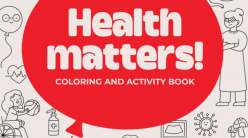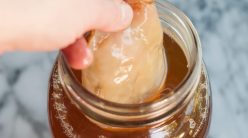
Here’s a fun science experiment to do with the kids that’s quick, educational and involves things you probably already have at home. Best of all, it’s really fun!
I found the directions here but this experiment can be found all over the internet.
This is a messy experiment that would be well suited for outside, but it’s also a great inside experiment to cure cabin fever.
Here’s what you need:
- An empty 20 or 24 ounce plastic bottle (another container of about the same size will work too, but the narrow opening helps make the toothpaste-like shape)
- 3% hydrogen peroxide (this is the standard stuff available at most stores)
- Liquid dishwashing detergent
- Warm water
- Food coloring (optional, but highly recommended)
- One packet or 2 1/2 teaspoons of active yeast (the type used for bread making)
- A big pot, bucket or other container to contain the mess (or do this in the sink or outside)
Here’s what you do:
- Dissolve the yeast in a little warm water and stir well. Use just enough water to make a pourable liquid. Let it sit for about 5 minutes while you prepare the rest of the experiment.
- Pour 1/2 cup of hydrogen peroxide, 1/4 cup of dish soap and a little bit of food coloring in the bottle. Swirl to mix and put the bottle in the middle of your large pot, container or sink.
- Pour the yeast solution into the bottle. A funnel can help, but be prepared to pour fairly quickly and remove it again because the reaction will start as soon as you start pouring.
- Stand back and watch the fun!
If kids want to touch the solution, it’s messy but safe. They’ll notice that it feels warm and you can tell them that it’s an exothermic reaction, meaning a reaction that produces heat. Do keep in mind that the food coloring will probably stain, so protect surfaces and clothes.
Here’s what’s happening:
Hydrogen peroxide (H2O2) is a reactive molecule that readily decomposes into water (H2O) and oxygen (O2):
2H2O2 –> 2H2O + O2
This happens all the time with hydrogen peroxide, but usually it happens so slowly it’s hard to see. When we put hydrogen peroxide on a cut, an enzyme in our blood is the catalyst that causes the hydrogen peroxide to break down (the bubbles are oxygen being released). In this demonstration, yeast is the catalyst. It causes the decomposition to speed up much more rapidly than normal. The dishwashing detergent captures the oxygen that is released, making foam. Food coloring can color the film of the bubbles so that you get colored foam.
This experiment demonstrates three kinds of reactions in one: an exothermic reaction (giving off heat), a catalyzed reaction (caused by the addition of something that speeds up a reaction without being destroyed itself) and a decomposition reaction (where something breaks down).
Have fun!




